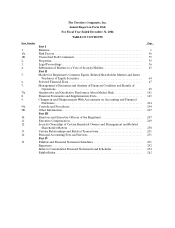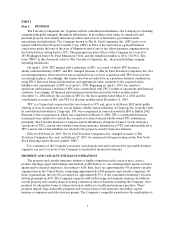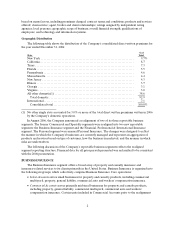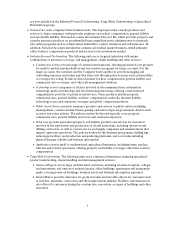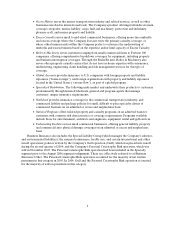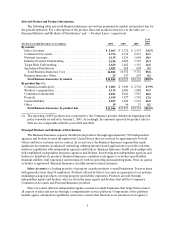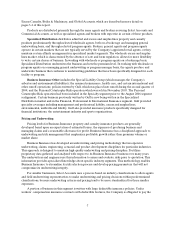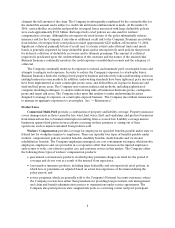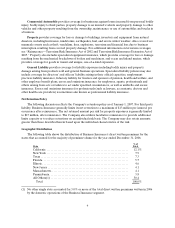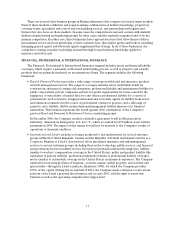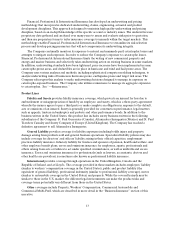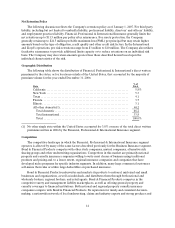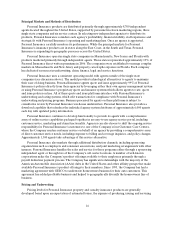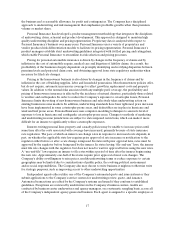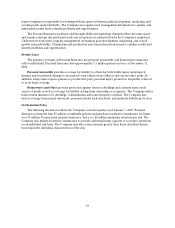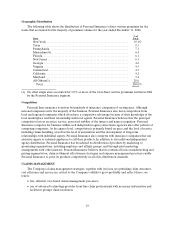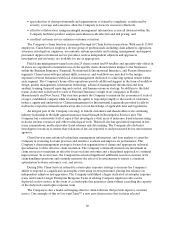Travelers 2006 Annual Report Download - page 22
Download and view the complete annual report
Please find page 22 of the 2006 Travelers annual report below. You can navigate through the pages in the report by either clicking on the pages listed below, or by using the keyword search tool below to find specific information within the annual report.10
Competition
The insurance industry is represented in the commercial marketplace by many insurance companies of
varying size as well as other entities offering risk alternatives such as self-insured retentions or captive
programs. Market competition works within the insurance regulatory framework to set the price charged
for insurance products and the level of service provided. Growth isdriven by a company’s ability to provide
insurance and services at aprice thatis reasonable and acceptable to the customer. In addition, the
marketplace is affected by available capacity of the insurance industry, as measured by policyholders’
surplus, and the availability of reinsurance. Surplus expands and contracts primarily in conjunction with
profit levels generated by the industry. Capital raised by debt and equity offerings also increases a
company’s surplus. Growth in premium and service business is also measured by a company’s ability to
retain existing customers and to attract new customers. Additionally, many large commercial customers
self-insure their risks or utilize large deductibles onpurchased insurance.
Select Accounts business is typically written through independent agents and, to a lesser extent,
regional brokers and direct writers. Both national and regional property casualty insurance companies
compete in the Select Accounts market which generally comprises lower hazard, “main street” business
customers. Risks are underwritten and priced using standard industry practices and a combination of
proprietary and standard industry product offerings. Competition in this market is primarily based on
price, product offerings and response time in policy services. Select Accounts has established a strong
marketing relationship with its distribution network and has provided it with defined underwriting policies,
a broad array of products, competitive prices and one of the most efficient automated environments in the
industry. In addition, the Company has established centralized service centers to help agents perform many
service functions, in return for a fee. Select Accounts’ overall service platform is one of the strongest in the
small business commercial market.
Commercial Accounts business has historically been written through independent agents and brokers,
although some companies usedirect writing. Competitors in this market are primarily national property
casualty insurance companies willing to write most classes of business using traditional products and
pricing, and regional insurance companies. Companies compete on price, product offerings, response time
in policy issuance and claim and loss prevention services. Additionally, improved efficiency through
automation and response time to customerneeds are key to success in this market.
The National Accounts group is comprised of three business units:
•National Accounts business is typically written through national brokers and, to a lesser extent,
regional brokers. Insurance companies compete in thismarket based on price, product offerings,
claim and loss prevention services, managed care cost containment and risk management
information systems. National Accounts also offers a large nationwidenetwork of localized claim
service centers which provide greater flexibility in claims adjusting and allows National Accounts to
more quickly respond to the needs of its customers.
•Discover Re competes with traditional providers of commercial insurance coverages, as well as
other underwriters of property and casualty insurance in the alternative risk transfer market, suchas
risk retentiongroups, self-insurance plans, captives managed by others, and a variety of other risk-
financing vehicles and mechanisms.
•National Accounts’ residual market business competes for state contracts to provide claims and
policy management services. These contracts, which generally have three-year terms, are selected by
state agencies through a bid process based on the quality of service and price. National Accounts
services approximately 36%of the total workers’ compensation assigned risk market, making the
Company one of the largest servicing carriers in the industry.


